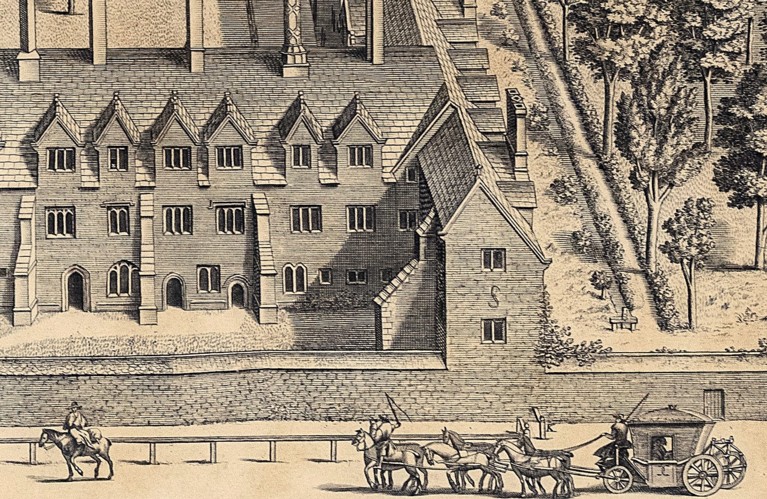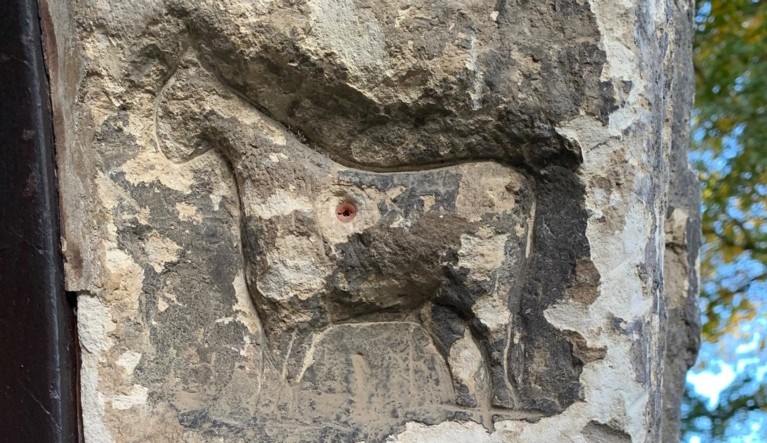Blog
2 April 2025
L is for … Library

The original college library was housed on the upper floor of a little wing extending towards St Andrew’s Street. It can be identified in an engraving of c.1690 (pictured) by the ‘S’ shaped iron wall brace inserted in 1657. The library is first mentioned in 1587, when its lighting was improved by the insertion of additional windows. An early inventory lists eleven ‘fayre desks of oake’, deal tables, stools, a globe, and wall panels showing celestial maps, Hebrew genealogical tables, and the names of all the college Fellows and benefactors since the foundation. Portraits of Sir Walter Mildmay and his son Anthony presided over the room. Thanks to generous donations, as well as purchases, there was soon an impressive stock of books, but keeping track of them was a challenge. A college order of 1600 prohibited any borrowing without the permission of the Master and Fellows, and ordered that a ‘note of remembrance’ be kept. This measure was clearly ineffective, as a draconian directive of 1609 forbade any borrowing whatsoever, and imposed a ‘mulch’ of 40 shillings on anyone who either removed books or took receipt of them. A stock-check made a year later revealed that 30 volumes were ‘Wanting’, but despite the losses Emmanuel never resorted to chaining its books, unlike some other colleges. As the numbers of both students and books increased, however (there were some 1000 volumes by 1630), it was clear that the library needed to be properly staffed. By 1628 the post of Keeper had been established, with an annual salary of £2.13.4. In the early days, the postholder was always a BA or MA graduate of the college, who was no doubt grateful for the modest stipend. The ban on borrowing was finally lifted in 1654.
L is for … Livestock

Emmanuel’s spacious Paddock was originally called ‘The Great Close’. In the days of the Dominicans it had undoubtedly been used for grazing livestock, and entries in the college accounts show that this continued for many years. In 1588 there is a payment of four shillings and sixpence ‘For tymber to make barrs to keep cattel out of the courts’, and in October 1590 a smith was paid for ‘mending the pump in the cowdytch’. There were stables within the precinct, for in those early days the Master and Fellows frequently hired horses when travelling on college business, and some members of the fellowship may even have kept their own mounts. An entry in the 1635 accounts records a payment of twopence ‘for penny cord to keep the horses off the quicksett’, probably a reference to the newly-planted hedge near Old Court. Perhaps the carving of what looks like a cow on the clunch archway of G staircase (pictured) was inspired by the local livestock. In 1735 the college ‘Horse block’ was repainted in ‘Lead Culler’ and it would certainly have been well-used, as horse-ownership had become common among the fellowship by this time (and would remain so until the railway came to town). The Parlour wager books, which begin in 1769, record many bets made between Fellows about their horses’ performances and other characteristics, and entries show that the purchase and sale of these steeds was generally celebrated with a bottle of wine. The coining of the term ‘Paddock’ in the late-nineteenth century could well be attributable to James Peace, Fellow and Bursar, who had devoted many hours to combing through the college’s early account books. The name was presumably chosen to evoke the days when horses were a delightful feature of the Emmanuel scene.
Amanda Goode, College Archivist